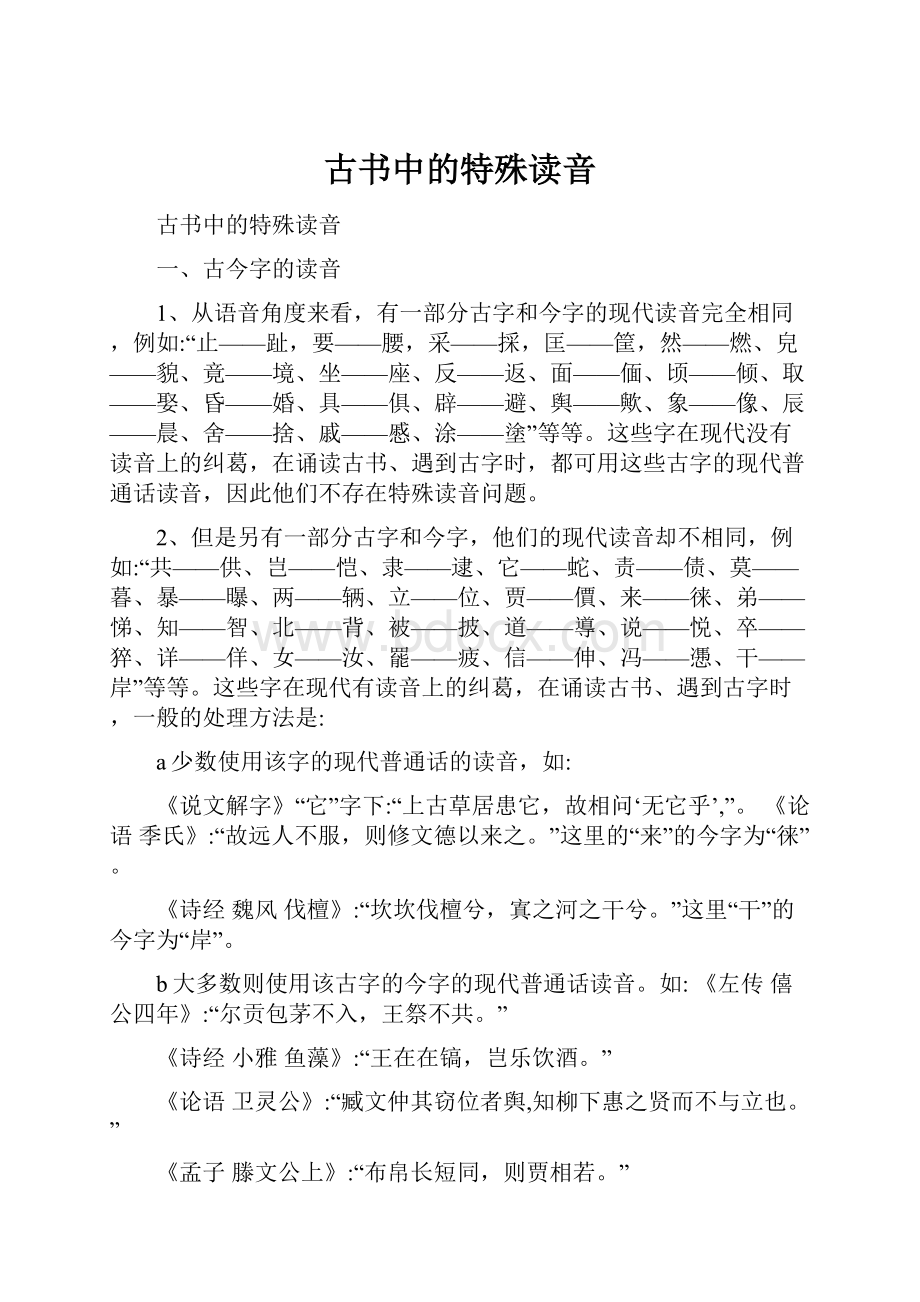古书中的特殊读音.docx
《古书中的特殊读音.docx》由会员分享,可在线阅读,更多相关《古书中的特殊读音.docx(8页珍藏版)》请在冰豆网上搜索。

古书中的特殊读音
古书中的特殊读音
一、古今字的读音
1、从语音角度来看,有一部分古字和今字的现代读音完全相同,例如:
“止——趾,要——腰,采——採,匡——筐,然——燃、皃——貌、竟——境、坐——座、反——返、面——偭、顷——倾、取——娶、昏——婚、具——俱、辟——避、舆——歟、象——像、辰——晨、舍——捨、戚——慼、涂——塗”等等。
这些字在现代没有读音上的纠葛,在诵读古书、遇到古字时,都可用这些古字的现代普通话读音,因此他们不存在特殊读音问题。
2、但是另有一部分古字和今字,他们的现代读音却不相同,例如:
“共——供、岂——恺、隶——逮、它——蛇、责——债、莫——暮、暴——曝、两——辆、立——位、贾——價、来——徕、弟——悌、知——智、北——背、被——披、道——導、说——悦、卒——猝、详——佯、女——汝、罷——疲、信——伸、冯——慿、干——岸”等等。
这些字在现代有读音上的纠葛,在诵读古书、遇到古字时,一般的处理方法是:
a少数使用该字的现代普通话的读音,如:
《说文解字》“它”字下:
“上古草居患它,故相问‘无它乎’,”。
《论语季氏》:
“故远人不服,则修文德以来之。
”这里的“来”的今字为“徕”。
《诗经魏风伐檀》:
“坎坎伐檀兮,寘之河之干兮。
”这里“干”的今字为“岸”。
b大多数则使用该古字的今字的现代普通话读音。
如:
《左传僖公四年》:
“尔贡包茅不入,王祭不共。
”
《诗经小雅鱼藻》:
“王在在镐,岂乐饮酒。
”
《论语卫灵公》:
“臧文仲其窃位者舆,知柳下惠之贤而不与立也。
”
《孟子滕文公上》:
“布帛长短同,则贾相若。
”
《论语学而》:
“学而时习之,不亦说乎,”
《战国策燕策》:
“群臣惊愕,卒起不意,尽失其度。
”这两种不同的处理方法,在何种情况下取何种,完全是根据人们的upgradeandexpansion,wholesystemconstructionofguidelinefollowedfollowingprinciples:
Advanced:
fullreferencebothathomeandabroadadvanced,andmatureoftechnology,andmethodandmeans,Projectdesign,technicalproductleader,matureproductsaspossibleonthemainequipmentselection,technicalleadandalignedwithnationalstandardsofgeneral-purpose,standardequipment.Systematization:
strictlyfollowtheviewofsystemengineeringandconstruction,hasalwaysbeentopracticeengineeringintegrity,hierarchy,andadaptabilitytotheexternalenvironmentforconstructivepurposes.Maximizethebusinessintegration,functionalintegrationandavoiddifferentproducts,differentstandardsandspecificationsofpiecingtogetherandcombinationofthesystem.Opennessandstandardization:
hardwaredeviceselectsthedomesticandforeignwell-knownproducts,systemarchitectureandprotocolstandardsareinaccordancewiththeITU-tinternationalindustrystandardsandISOstandardsofdesign,coresystemsanddevices,followinginternationalstandards,harmonizationofstandards,ensuresystemscalabilityandcontinuityofthesystem.Practicality:
ensurehighavailabilityofthesystemperformancewithhighreliabilityandflexibilityboth;firsttoensurestableandreliableoperationofthesystem,andusingredundancydesignofkeycomponentsofthekeypositionthentosimple,technologicallyadvanced,economicalandpractical.Extensibleandmaintainable:
withintheexpectedlifecycleofsystemsorequipment,canbeupgradedandmodifiedtomeettheneedsoftheuseractionsandapplicationrequirementschange.Andensuresafter-salesservice
习惯,不过为了照顾语意的理解,我们认为后者的处理方法为好。
由于后一种处理方法把古字读成不同于它现代普通话的读音(即今字的读音),因此对于这些古字来说,就形成了特殊的读音。
二、通假字的读音
1、一类是通假字与本字的现代读音完全一致,这类没有读音上的纠葛。
如“谓——为、芥——介、视——示、钧——均、奉——俸、错——措、式——轼、辨——辩、以——已、豫——预、免——娩、逝——誓、熙——嬉、燕——宴、谊——义、常——尝、尔——迩、蚤——早、惠——慧、无——毋”等等。
2、另一类是通假字和本字的现代普通话读音不一致,如“亡——无、能——耐、有——又、属——嘱、矜——鳏、害——曷、爵——雀、政——征、归——馈、矢——誓、干——涧、生——性、章——彰、敛——殓、拂——弼、适——谪、亡——忘、缪——穆、耆——嗜”等等。
a传统处理是绝大多数通假字按照本字的现代普通话读音来读,如:
《论语颜渊》:
“人皆有兄弟,我独亡。
”无
《淮南子地形训》:
“食水者善游能寒。
”耐
《战国策齐策》:
“使人属孟尝君,愿寄食门下。
”嘱《礼记礼运》:
“矜寡孤独废疾者皆有所养。
”鳏
《诗经周南葛覃》:
“害澣(同浣)害否,归宁父母。
”曷《韩非子说林下》:
“人不能自止于足,而亡其富之涯乎。
”忘b只有极少数通假字仍依他们的现代读音来读。
如:
《诗经小雅斯干》:
“秩秩斯干,幽幽南山。
”干通涧,仍读gān《左传宣公二年》:
“三进及溜,而后视之。
”溜通霤,读liū,不读liù
这样,对于绝大多数通假字来说,由于不按照他们自身的现代读音,而是按照本字的现代读音来读,也就形成了特殊的读音。
三、读破
读破是利用字词的读音变化来表示词义和词类的变化,这种读音的变化主要是声调的变化,即四声别义。
其次也有利用声母的变化来表示的。
例如:
《广韵》:
“朝”,陟遥切,早也;直遥切,朝廷也。
“見”,古电切,视也;胡甸切,露也。
upgradeandexpansion,wholesystemconstructionofguidelinefollowedfollowingprinciples:
Advanced:
fullreferencebothathomeandabroadadvanced,andmatureoftechnology,andmethodandmeans,Projectdesign,technicalproductleader,matureproductsaspossibleonthemainequipmentselection,technicalleadandalignedwithnationalstandardsofgeneral-purpose,standardequipment.Systematization:
strictlyfollowtheviewofsystemengineeringandconstruction,hasalwaysbeentopracticeengineeringintegrity,hierarchy,andadaptabilitytotheexternalenvironmentforconstructivepurposes.Maximizethebusinessintegration,functionalintegrationandavoiddifferentproducts,differentstandardsandspecificationsofpiecingtogetherandcombinationofthesystem.Opennessandstandardization:
hardwaredeviceselectsthedomesticandforeignwell-knownproducts,systemarchitectureandprotocolstandardsareinaccordancewiththeITU-tinternationalindustrystandardsandISOstandardsofdesign,coresystemsanddevices,followinginternationalstandards,harmonizationofstandards,ensuresystemscalabilityandcontinuityofthesystem.Practicality:
ensurehighavailabilityofthesystemperformancewithhighreliabilityandflexibilityboth;firsttoensurestableandreliableoperationofthesystem,andusingredundancydesignofkeycomponentsofthekeypositionthentosimple,technologicallyadvanced,economicalandpractical.Extensibleandmaintainable:
withintheexpectedlifecycleofsystemsorequipment,canbeupgradedandmodifiedtomeettheneedsoftheuseractionsandapplicationrequirementschange.Andensuresafter-salesservice
“著”,张略切,服衣于身;直略切,附也。
“解”,佳贾切,讲也,说也;胡贾切,晓也。
“乐”,五角切,音乐;盧各切,喜乐。
读破所造成的字音变化,有的一直沿用到现代普通话,但是也有大量的读破音没有被现代普通话所继承。
原因有二:
1、读破音所造成的字词现代已经废弃不用,或者已由其它字词代替。
如:
《论语公冶长》:
“子谓公冶长:
‘可妻也。
虽在縲絏(同绁)之中,非其罪也。
’以其子妻之。
”妻,以女适人也,旧读qì,此义今用嫁。
《孟子梁惠王上》:
“保民而王,莫之能御也。
”王,成就霸业,旧读wàng,此义今已不用。
2、汉语语音的不断简化,使原来有异的读音变得相同。
如:
败:
《广韵》:
“以豉切,难易也,简易也;羊益切,变易。
”两音合而为一。
两音为去声入声之别,后因“入派三声”,两音合而为一。
1、我们读古书的时候,对于那些一直沿用到现代汉语普通话的读破,当然是应该遵从的。
2、而对于那些并不为现代普通话所继承的读破,则可以根据一般的习惯,有的遵从读破音,如“王、衣、雨、从、闻、风、间、与、骑、语、解”等等,由于在古书中出现颇多,一般都遵从读破音。
3、有的就依照现代普通话的读音。
而其他一些字,则一般就依照现代普通话的读音,如“去”,《广韵》丘倨切(qù),离也,羌举切(qǔ),除也,今一概读qù。
当然,所谓遵从读破音,还是要限于现代普通话语音系统可能允许的范围内,并不是要求我们完全模仿古人的读音。
四、专有名词的读音
1、人名和称号
宓羲(伏羲)fx夫差fchi皋陶(咎繇)goyo伍員wyn契xi句踐gujin尼父nf趙衰zhocu墨翟md角里ll叔孙婼shsncho禽滑釐qnggl且姚jyo酈食其lyj祭仲zhizhng鉛陵卓子upgradeandexpansion,wholesystemconstructionofguidelinefollowedfollowingprinciples:
Advanced:
fullreferencebothathomeandabroadadvanced,andmatureoftechnology,andmethodandmeans,Projectdesign,technicalproductleader,matureproductsaspossibleonthemainequipmentselection,technicalleadandalignedwithnationalstandardsofgeneral-purpose,standardequipment.Systematization:
strictlyfollowtheviewofsystemengineeringandconstruction,hasalwaysbeentopracticeengineeringintegrity,hierarchy,andadaptabilitytotheexternalenvironmentforconstructivepurposes.Maximizethebusinessintegration,functionalintegrationandavoiddifferentproducts,differentstandardsandspecificationsofpiecingtogetherandcombinationofthesystem.Opennessandstandardization:
hardwaredeviceselectsthedomesticandforeignwell-knownproducts,systemarchitectureandprotocolstandardsareinaccordancewiththeITU-tinternationalindustrystandardsandISOstandardsofdesign,coresystemsanddevices,followinginternationalstandards,harmonizationofstandards,ensuresystemscalabilityandcontinuityofthesystem.Practicality:
ensurehighavailabilityofthesystemperformancewithhighreliabilityandflexibilityboth;firsttoensurestableandreliableoperationofthesystem,andusingredundancydesignofkeycomponentsofthekeypositionthentosimple,technologicallyadvanced,economicalandpractical.Extensibleandmaintainable:
withintheexpectedlifecycleofsystemsorequipment,canbeupgradedandmodifiedtomeettheneedsoftheuseractionsandapplicationrequirementschange.Andensuresafter-salesservice
ynlngzhuz
樊於期fnwj亢倉子(亢桑子)gngsngz
召伯shob咸宣jinxun解張jizhng牟光mugung不準fuzhn逢蒙(逢門)pngmn龍且lngj繁延壽pynshu種暠chngha曹大家codg汗明hanmng可汗khn能勝之naishengzhi單于chny万俟卨moqixie閼氏(焉提)ynzh
尉遲恭ychgng冒頓md蓋寬饒gkunro呼韓邪hhny猗頓ydn昆邪(渾耶)hny兒寬nkun谷蠡ll眭弘suhng區冶uy金日磾jnmd
2、地名
於陵wlng宛朐yunq鎬京hojng龍兌lngdu不羹blng陽夏yngji會稽kuij番禺pny番陽pyng葉sh阿房宮pnggng費b六合lh蔚y
卷縣qunxin華不注hufzh祝其zhj天姥山tinmshn東阿dng繁峙fnsh瀧水shungshu黽池minch莘shn黽阨mng台州tizhu祖厲jul令狐lngh渦河guh令居linj櫟陽lyngupgradeandexpansion,wholesystemconstructionofguidelinefollowedfollowingprinciples:
Advanced:
fullreferencebothathomeandabroadadvanced,andmatureoftechnology,andmethodandmeans,Projectdesign,technicalproductleader,matureproductsaspossibleonthemainequipmentselection,technicalleadandalignedwithnationalstandardsofgeneral-purpose,standardequipment.Systematization:
strictlyfollowtheviewofsystemengineeringandconstruction,hasalwaysbeentopracticeengineeringintegrity,hierarchy,andadaptabilitytotheexternalenvironmentforconstructivepurposes.Maximizethebusinessintegration,functionalintegrationandavoiddifferentproducts,differentstandardsandspecificationsofpiecingtogetherandcombinationofthesystem.Opennessandstandardization:
hardwaredeviceselectsthedomesticandforeignwell-knownproducts,systemarchitectureandprotocolstandardsareinaccordancewiththeITU-tinternationalindustrystandardsandISOstandardsofdesign,coresystemsanddevices,followinginternationalstandards,harmonizationofstandards,ensuresystemscalabilityandcontinuityofthesystem.Practicality:
ensurehighavailabilityofthesystemperformancewithhighreliabilityandflexibilityboth;firsttoensurestableandreliableoperationofthesystem,andusingredundancydesignofkeycomponentsofthekeypositionthentosimple,technologicallyadvanced,economicalandpractical.Extensibleandmaintainable:
withintheexpectedlifecycleofsystemsorequipment,canbeupgradedandmodifiedtomeettheneedsoftheuseractionsandapplicationrequirementschange.Andensuresafter-salesservice
犍為qinwi蒲姑bg査瀆zhd休屠xich句凟gudu烏氏wzh允吾qiny邏些(邏娑)lusu3、國家和民族名
龜玆qi(或ji)c身毒yund大宛dyun烏wh康居kngq婼羌ruqing月氏ru(yu)zh且末jm扜彌wm吐谷渾tyhn高句麗gogul熏育(葷粥)xny健馱羅qintulu先零xinlin廧咎如qinggor吐蕃tb(或fn)4、物名
射干ygn
無射wy古十二律之一。
位于戌,故亦指阴历九月
周景王所铸钟名。
后亦泛指大钟。
5、官职名
寺人shrn
追师dush
冯相氏pngxingsh
卝人kungrn
廧夫
条狼氏dlngsh
红女
蜡氏
庶氏
upg